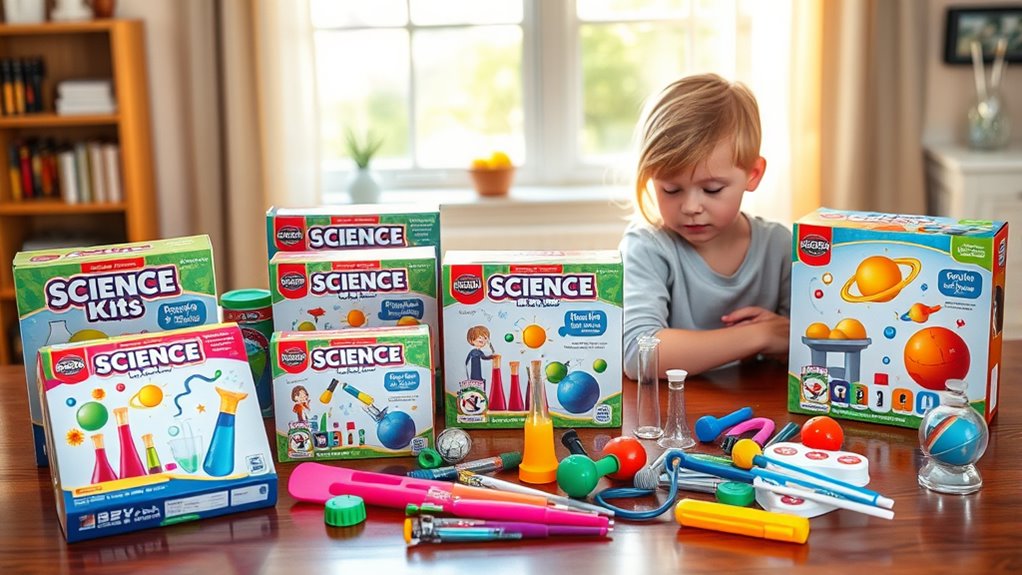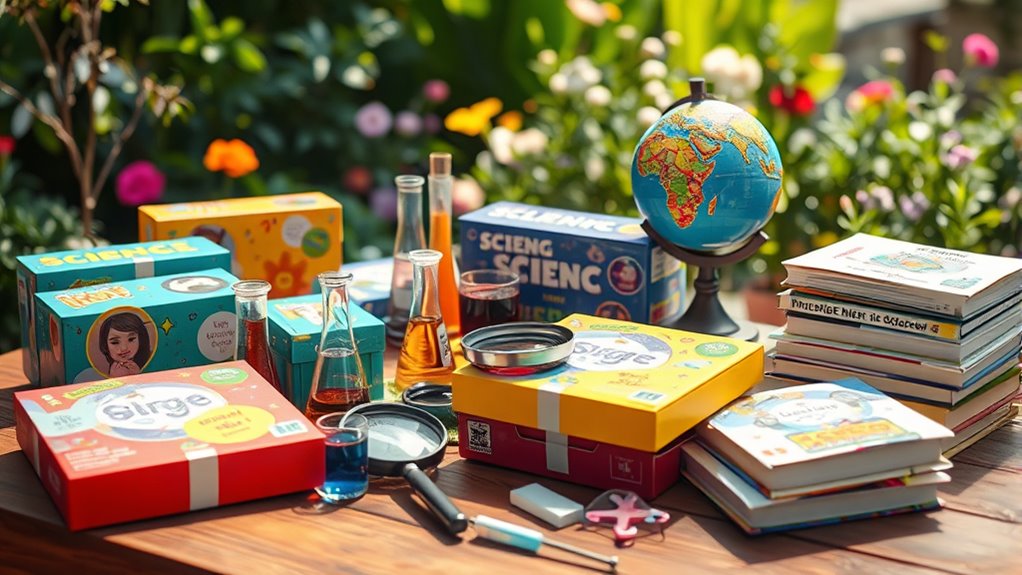I’ve found some amazing science kits that really inspire curiosity and learning in young minds. The Doctor Jupiter Science Kit has over 135 experiments, perfect for ages 8 to 14. For younger kids, the Scientific Explorer Kit is a fun choice. Other standout options include the 4M Crystal Growing Kit and the Clean Water Science Kit, which teach important concepts through hands-on play. There’s so much more to discover about these fantastic kits!
Key Takeaways
- Look for science kits that offer a variety of hands-on experiments to engage children and spark their curiosity about STEM topics.
- Ensure the kits are age-appropriate, promoting safety and understanding based on the developmental stage of the child.
- Select kits with clear instructions and high-quality materials for durability and ease of use during experiments.
- Consider the educational value of each kit, focusing on those that foster critical thinking and problem-solving skills.
- Read user reviews to identify kits that have positive feedback regarding enjoyment, effectiveness, and engagement in scientific exploration.
Doctor Jupiter Science Kit for Kids (STEM Toy with 135+ Experiments)
If you’re looking for a science kit that truly engages kids aged 8 to 14, the Doctor Jupiter Science Kit is an excellent choice. With over 135 experiments, it sparks curiosity through exciting activities like color changes and underwater volcanoes. I love how it promotes STEM learning, fostering problem-solving skills and creativity. Parents can easily engage in experiments with their kids, making lasting memories together. The clear instructions make it simple for everyone, and it’s perfect for any occasion, be it birthdays or holidays. Overall, this kit offers both educational fun and a unique bonding experience that kids won’t forget!
Best For: Kids aged 8 to 14 who are interested in science and hands-on experiments.
Pros:
- Promotes STEM learning and fosters problem-solving skills.
- Encourages parent-child bonding through shared scientific exploration.
- Offers over 100 hours of educational fun with easy-to-follow instructions.
Cons:
- Some users noted the need for additional supplies to extend experiments.
- A few complaints about leaking materials during experiments.
- Difficulty accessing certain components reported by some users.
Scientific Explorer My First Mind Blowing Science Experiment Kit
The Scientific Explorer My First Mind Blowing Science Experiment Kit is perfect for curious kids aged 6 and up who want to plunge into the exciting world of science. With 20 pieces and materials for 11 fun activities, kids can explore color-changing liquids, create magic ooze, and even make an underwater volcano! Each experiment comes with clear instructions and fun scientific secrets, encouraging learning through play. While adult supervision is recommended, parents can join in the fun too. This kit is not just engaging; it’s a fantastic way to introduce STEM concepts and spark a lifelong love for science.
Best For: Curious kids aged 6 and up who want to explore hands-on science experiments.
Pros:
- Engaging and fun activities that promote learning through play.
- Clear instructions and scientific explanations make it easy to understand concepts.
- High-quality equipment and reusable materials for ongoing experimentation.
Cons:
- Adult supervision is recommended, especially for certain experiments.
- Some common household items are required, which may not be readily available.
- Purple cabbage powder can stain, requiring caution during use.
4M Crystal Growing Science Experimental Kit
For budding scientists enthusiastic to explore the wonders of crystal formation, the 4M Crystal Growing Science Experimental Kit stands out as an exceptional choice. This kit includes materials for seven engaging experiments, allowing you to grow a variety of crystals in different shapes and colors. With easy-to-follow instructions, you’ll mix crystal compounds with hot water and watch the magic unfold. Patience is key, as full formation takes 4-7 days. Plus, the included display case lets you showcase your creations! Despite some comparisons to pricier kits, I found it an excellent introduction to the fascinating world of crystals.
Best For: The 4M Crystal Growing Science Experimental Kit is best for kids aged 10 and up who are interested in STEM activities, particularly in chemistry and geology.
Pros:
- Engaging and educational, promoting hands-on learning about crystal formation.
- Includes a variety of materials for seven different crystal growth experiments.
- Positive user feedback highlights the fun and variety of crystal shapes and colors.
Cons:
- Some users feel the quality of materials is not as high as more expensive kits.
- Requires patience, as full crystal formation takes 4-7 days.
- Lacks dedicated containers for each experiment, which may affect ease of use.
60+ Science Experiment Kit for Kids Ages 5-8
Designed specifically for kids ages 5-8, the 60+ Science Experiment Kit sparks a love for science through hands-on activities that are both fun and educational. I’ve seen kids erupt in excitement while creating volcanic eruptions and digging for dinosaur eggs. Each experiment promotes exploration and enhances cognitive skills, making them think critically. The kit comes with everything needed, including safety goggles and easy-to-follow instructions, which I found incredibly helpful. It makes a fantastic gift for birthdays or holidays. Parents rave about the hours of engagement it provides, though some experiments may take a bit longer for results, so planning ahead is key!
Best For: Kids ages 5-8 who are eager to explore science through engaging and hands-on experiments.
Pros:
- Encourages curiosity and critical thinking through fun, interactive STEM activities.
- All-inclusive kit with safety goggles and easy-to-follow instructions for simple execution.
- Highly recommended by parents for providing hours of entertainment and educational value.
Cons:
- Some experiments may require additional common household items not included in the kit.
- A few experiments can take several days to show results, requiring advance planning.
- Caution is advised for small children due to small components that may pose a choking hazard.
4M Clean Water Science – Climate Change Educational STEM Toy
Looking for an engaging way to introduce your child to environmental science? The 4M Clean Water Science kit is perfect! This personal desalination kit teaches kids how to extract salt from seawater through fun experiments. It includes everything needed—active carbon, sand, and a plastic filter system—to build a tabletop water filtration plant powered by solar energy. I love how it sparks curiosity about water purification and climate change. With clear instructions and fascinating facts, it’s suitable for kids aged 8 and up, making it an excellent addition to any homeschool or school science curriculum. Let’s inspire young minds together!
Best For: The 4M Clean Water Science kit is best for children aged 8 and up who are interested in environmental science and hands-on learning.
Pros:
- Engaging and educational, promoting interest in chemistry and environmental science.
- Includes all necessary components for building a functional water filtration and desalination plant.
- Positive customer feedback highlights its effectiveness for science projects and homeschool curricula.
Cons:
- Some users report the need for better quality in certain components.
- Suggestions for a heavier collector for improved stability have been noted.
- May require adult supervision for younger children during assembly and experiments.
hand2mind Magnetic Science Kit for Kids 8-12
The hand2mind Magnetic Science Kit is a fantastic choice for curious kids aged 8-12 who want to explore the world of magnetism. With nine engaging experiments, it lets kids make magnets float, move a train using magnetic levitation, and even create a compass. I love how it promotes hands-on learning with real lab tools while encouraging critical thinking. Plus, the 20-page guide is clear and informative. Parents rave about how it keeps kids entertained for hours, making it a great investment. This kit isn’t just fun; it sparks interest in STEM careers, making learning enjoyable and valuable.
Best For: Curious kids aged 8-12 who want to explore the world of magnetism through hands-on experiments.
Pros:
- Engaging and educational experiments that promote critical thinking and collaboration.
- High-quality materials and durability ensure long-term use without consumable parts.
- Clear and informative instruction manual that enhances the learning experience.
Cons:
- Some younger children (3-7 years) may require parental supervision to fully engage with the kit.
- Limited to magnetism experiments, which may not appeal to all children’s interests.
- Initial setup may require adult assistance for younger users to ensure safety and understanding.
NATIONAL GEOGRAPHIC Ultimate Volcano Kit for Kids
If you’re searching for an engaging way to spark your child’s interest in science, the NATIONAL GEOGRAPHIC Ultimate Volcano Kit for Kids is an excellent choice. This hands-on kit includes everything needed for exciting eruptions, featuring 3x more eruption powder and pop crystals for thrilling sounds. The realistic paint colors and clear instructions make assembling the lifelike volcano easy. It teaches chemistry and geology through interactive experiments, igniting curiosity about how volcanoes work. With over 4,100 reviews and a 4.6-star rating, it’s perfect for ages 8 and up. Just be mindful of potential mess during the eruptions!
Best For: Children aged 8 and up who are interested in science and hands-on learning about volcanoes.
Pros:
- Engages children in STEM learning through chemistry and geology experiments.
- High-quality materials ensure durability and safety during use.
- Clear instructions and realistic designs make assembly and painting easy and enjoyable.
Cons:
- Eruption process can be messy, requiring cleanup precautions.
- May stain surfaces, so care must be taken during experiments.
- Adult supervision is recommended for younger kids to ensure safety.
Doctor Jupiter My First Science Kit for Kids
For kids aged 4 to 8, Doctor Jupiter My First Science Kit offers an exciting gateway into the world of science. With over 100 experiments, it encourages curiosity and problem-solving. I love how it’s designed for both boys and girls, providing screen-free fun that sparks imagination. The well-illustrated manuals make it easy for kids and parents to follow along, promoting critical thinking. It meets safety standards, so I feel secure letting my little ones explore. Although some users mention needing extra supplies, the kit is still a fantastic gift for budding scientists, making learning engaging and enjoyable during family time.
Best For: Kids aged 4 to 8 who are curious about science and enjoy hands-on learning experiences.
Pros:
- Encourages critical thinking and problem-solving through over 100 engaging experiments.
- Designed for both boys and girls, promoting inclusivity and screen-free fun.
- Well-illustrated instruction manuals make it easy for kids and parents to follow along.
Cons:
- Some users mention the need for additional supplies to fully extend experiments.
- Priced around $37, with some feeling the contents are basic for the cost.
- May not provide enough variety for children who quickly master the initial experiments.
Snap Circuits Jr. SC-100 Electronics Exploration Kit for Kids 8
Looking for an engaging way to introduce your child to the world of electronics? The Snap Circuits Jr. SC-100 Exploration Kit is perfect for kids aged 8 and up. With 28 snap-together parts, they can create over 100 exciting projects, like a sound-activated switch or a musical doorbell. The kit’s manual features clear illustrations and easy directions, making learning fun and straightforward. Plus, with a stellar 4.8-star rating from thousands of reviews, it’s a hit among families. This award-winning kit not only promotes hands-on learning but also encourages family interaction—perfect for sparking curiosity and creativity in young minds!
Best For: The Snap Circuits Jr. SC-100 Electronics Exploration Kit is best for children aged 8 and up who are interested in learning about electronics and circuitry through hands-on projects.
Pros:
- Engages children with over 100 projects that teach electronics fundamentals.
- Simple assembly with snap-together components, requiring no soldering.
- High customer satisfaction with a 4.8-star rating and positive feedback on support.
Cons:
- Requires two AA batteries that are not included in the kit.
- Limited to the 28 parts included, may require additional kits for more advanced projects.
- Some children may need adult supervision or assistance with complex projects.
Einstein’s Young Survivor Science Kit for Kids
Einstein’s Young Survivor Science Kit for Kids is perfect for curious kids aged 8 and up who want to immerse themselves in the world of science through hands-on learning. This kit offers over a dozen exciting experiments focused on survival techniques, like generating water from plants and lighting a fire without matches. Equipped with essential tools such as a magnifying glass and climbing rope, it encourages problem-solving skills. While the educational value is high, some users note unclear instructions and the need for additional materials. I recommend preparing in advance to make the most of this engaging and exploratory experience for your young scientist!
Best For: Curious kids aged 8 and up who are eager to explore science through hands-on experiments focused on survival techniques.
Pros:
- Engages children with over a dozen exciting and educational experiments.
- Encourages problem-solving skills and scientific exploration.
- Suitable for both home and school settings, making it ideal for homeschooling.
Cons:
- Some users report unclear instructions that can lead to confusion.
- Additional common household materials may be required for certain experiments, which can create preparation challenges.
- Mixed feedback regarding user experience, with some feeling disappointed by the kit’s contents.
hand2mind Little Minds at Work Science of Reading Essentials Toolkit (Set of 6)
The hand2mind Little Minds at Work Science of Reading Essentials Toolkit is perfect for educators seeking to enhance early literacy instruction for young learners. This extensive set includes decodable reading manipulatives and phonemic awareness tools, making reading fun and engaging. I love how the color-coded manipulatives visually represent beginning, middle, and ending sounds. The hands-on activities facilitate phonics, fluency, and vocabulary development, catering to different learning styles. Created by Tara West, the toolkit has received rave reviews for its effectiveness in boosting student engagement and success, especially for those struggling with phonics. It’s a fantastic resource for any early childhood classroom!
Best For: Educators looking to enhance early literacy instruction for preschool students through engaging, multisensory learning tools.
Pros:
- Hands-on manipulatives promote active learning and cater to various learning styles.
- Color-coded components help students visually understand phonemic concepts, enhancing decoding skills.
- Positive user feedback highlights increased student engagement and effectiveness in teaching phonics.
Cons:
- Some components may require additional exploration to maximize their use in lessons.
- Toolkit size may be cumbersome for smaller classroom spaces or limited storage.
- Initial investment may be higher compared to traditional reading resources.
Butterfly Edufields 150+ Science Kits for Kids (Age 8-14)
For kids aged 8 to 14, Butterfly Edufields 150+ Science Kits stand out as an engaging choice to spark curiosity in young minds. With over 150 hands-on experiments ranging from volcano science to chemistry sets, this kit offers endless fun. I love how it encourages creativity and problem-solving while covering essential STEM concepts. Each kit comes with clear, step-by-step instructions, making it easy for kids to explore with minimal adult help. Plus, it meets safety standards, ensuring a reliable experience. Whether for birthdays or holidays, these kits are a hit, providing both learning and enjoyment for curious young scientists.
Best For: Kids aged 8-14 who are curious about science and enjoy hands-on experiments.
Pros:
- Engaging and educational with over 150 hands-on science experiments that promote STEM learning.
- Clear, step-by-step instructions allow for independent exploration with minimal adult assistance.
- High-quality materials and adherence to safety standards ensure a reliable and safe experience.
Cons:
- Some users report missing items in the kit, which can be frustrating.
- Suggestions for improvement include the addition of visual aids or video tutorials to enhance learning.
- Storage solutions for the materials could be better organized for ease of use.
Factors to Consider When Choosing Science Kits for Young Minds

When I’m picking science kits for kids, I always consider a few key factors. Age appropriateness, educational value, and safety standards top my list. It’s essential to find kits that spark curiosity while ensuring they’re engaging and safe to use.
Age Appropriateness
Choosing the right science kit involves understanding age appropriateness, as it guarantees that the activities match a child’s developmental stage. Science kits are designed with specific age ranges in mind, ensuring that the complexity of experiments aligns with their cognitive and motor skills. For little ones, I look for simpler experiments with easy-to-follow instructions, while older kids can handle more complex scientific principles. It’s also essential that these kits consider safety, using materials and activities that minimize risks. When I choose a kit that fits their age, I see not only an increase in their understanding of science but also a boost in their confidence as they successfully tackle experiments. Age-appropriate kits truly inspire curiosity and hands-on learning.
Educational Value
While selecting a science kit, I always prioritize its educational value, as this determines how effectively it will engage young minds. I look for kits that offer a variety of hands-on experiments promoting STEM learning. These kits should encourage critical thinking and problem-solving skills, making learning both fun and effective. I appreciate step-by-step instructions that lead to engaging activities, allowing kids to explore and discover on their own. It’s essential that each experiment aligns with educational standards, covering scientific concepts like chemical reactions and environmental science. I prefer kits designed for minimal adult supervision, fostering independence while still encouraging shared experiences. Ultimately, a wide range of experiments—ideally over 100 hours—helps instill a lifelong love for science and creativity.
Experiment Variety
The educational value of science kits naturally leads to the importance of experiment variety. I’ve seen firsthand how diverse activities keep kids engaged and spark their curiosity. Some kits even offer over 100 experiments, covering everything from chemistry to physics and earth science. This diversity promotes a well-rounded understanding of STEM principles. I love how kits that combine hands-on experiments with theoretical components help kids connect practical applications to scientific theories. It also helps that many experiments use common household items, allowing for continuous exploration long after the kit’s contents are finished. Plus, variety caters to different learning styles, ensuring that visual, auditory, and kinesthetic learners can find activities that excite them.
Safety Standards
When it comes to selecting science kits for young minds, safety standards play an essential role in ensuring a positive and secure learning experience. I always look for kits that comply with ASTM F963-17, as this means they’ve been tested for harmful substances. Non-toxic materials are a must, minimizing health risks during experimentation. It’s also important to check for clear labeling and age-appropriate instructions, which help kids use kits suited to their developmental stage safely. I appreciate kits designed with child safety in mind, featuring rounded edges and secure packaging to prevent choking hazards. Finally, I always recommend parental supervision for experiments that involve potentially hazardous materials, reinforcing the importance of adult involvement in maintaining safety during scientific exploration.
Ease of Use
Choosing the right science kit can be a game-changer for young learners, especially if it’s easy to use. I always look for kits that come with step-by-step, well-illustrated instructions. This way, kids can easily follow along and grasp the experiments. Kits designed for independent exploration are fantastic; they encourage self-learning and problem-solving with minimal supervision. It’s also vital to find kits that include all necessary materials to cut down on setup time. Clear labeling and organized components help children quickly identify what they need for each activity. Finally, choosing kits tailored to a specific age range guarantees they align better with kids’ cognitive and motor skills, making the entire process smoother and more enjoyable.
Parental Involvement
Finding the right science kit isn’t just about ease of use; it also involves considering how much parental involvement is encouraged. I’ve found that kits promoting shared exploration create lasting memories. When we engage in hands-on activities together, I see my child’s curiosity and critical thinking skills flourish. Many kits come with clear, step-by-step instructions, making it easy for me to guide them through experiments. Plus, some activities may require my supervision for safety, especially those involving reactive substances. I love how these kits spark meaningful discussions about scientific concepts, allowing my child to ask questions and deepen their understanding. Choosing a kit that fosters this kind of engagement can truly enhance the learning experience.
Frequently Asked Questions
What Age Range Are These Science Kits Suitable For?
When I look at science kits, I often wonder about their age suitability. Typically, these kits cater to children aged 5 to 12, but it really depends on the complexity of the projects. Younger kids benefit from simpler, hands-on activities, while older ones thrive with more challenging experiments. I always check the packaging for age recommendations to verify the kit aligns with my child’s interests and abilities. It makes all the difference!
Do These Kits Require Adult Supervision for Experiments?
When I think of bubbling potions and colorful explosions, I can’t help but get excited about science experiments! Yes, many of these kits do require adult supervision, especially for younger kids. It’s vital to keep safety in mind while exploring the wonders of science. I’ve found that having an adult around not only guarantees safety but also makes the experience more enriching and fun. So, gear up and jump into those experiments together!
How Long Do the Experiments Typically Take to Complete?
When I immerse myself in experiments, I find they usually take anywhere from 30 minutes to a few hours to complete. It really depends on the complexity of the activity. Some simpler experiments can be wrapped up quickly, while others might require more time for setup and observation. I often enjoy taking my time, allowing the science to unfold naturally and making sure I fully grasp the concepts behind what I’m doing.
Are the Materials in These Kits Safe and Non-Toxic?
Imagine a wild lab where kids are concocting colorful potions and launching fizzy rockets! You might wonder, are the materials in these kits safe and non-toxic? I can assure you, they’re designed with safety in mind. Most kits use non-toxic substances, so I feel confident letting my kids explore. Always check the labels, but I’ve found these kits prioritize my child’s safety while fueling their curiosity and imagination. It’s a win-win!
Can These Kits Be Reused for Multiple Experiments?
Absolutely, I’ve found that many science kits are designed for multiple experiments. It’s great because I can explore different concepts without needing to buy new materials each time. I often reuse components, mixing and matching for new projects. This not only saves me money but also sparks my creativity. Plus, it’s exciting to see how the same materials can yield different results each time I try something new!
Conclusion
In exploring these amazing science kits, I’ve realized that curiosity is the true engine of learning. Each kit not only sparks interest but also nurtures critical thinking and creativity. By encouraging young minds to experiment and question, we’re shaping future innovators and problem-solvers. So, as you choose a science kit, remember that it’s more than just a toy—it’s an opportunity to inspire a lifelong love for discovery and understanding of the world around us.






















